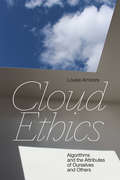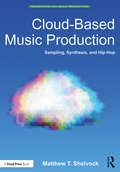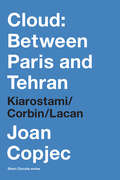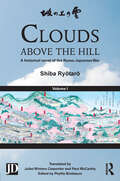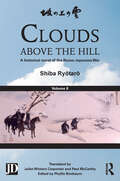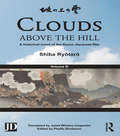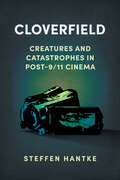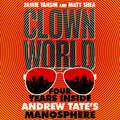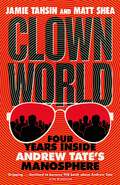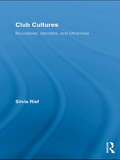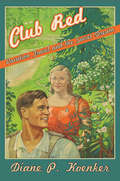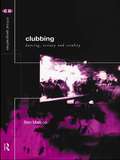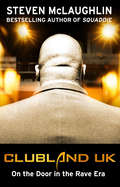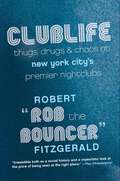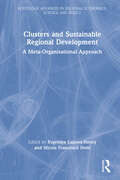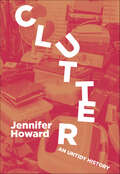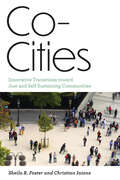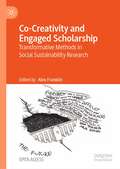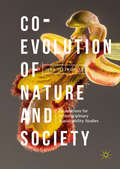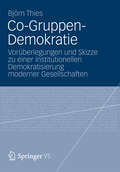- Table View
- List View
Cloud Ethics: Algorithms and the Attributes of Ourselves and Others
by Louise AmooreIn Cloud Ethics Louise Amoore examines how machine learning algorithms are transforming the ethics and politics of contemporary society. Conceptualizing algorithms as ethicopolitical entities that are entangled with the data attributes of people, Amoore outlines how algorithms give incomplete accounts of themselves, learn through relationships with human practices, and exist in the world in ways that exceed their source code. In these ways, algorithms and their relations to people cannot be understood by simply examining their code, nor can ethics be encoded into algorithms. Instead, Amoore locates the ethical responsibility of algorithms in the conditions of partiality and opacity that haunt both human and algorithmic decisions. To this end, she proposes what she calls cloud ethics—an approach to holding algorithms accountable by engaging with the social and technical conditions under which they emerge and operate.
Cloud-Based Music Production: Sampling, Synthesis, and Hip-Hop (Perspectives on Music Production)
by Matthew T. ShelvockCloud-Based Music Production: Samples, Synthesis, and Hip-Hop presents a discussion on cloud-based music-making procedures and the musical competencies required to make hip-hop beats. By investigating how hip-hop producers make music using cloud-based music production libraries, this book reveals how those services impact music production en masse. Cloud-Based Music Production takes the reader through the creation of hip-hop beats from start to finish – from selecting samples and synthesizer presets to foundational mixing practices – and includes analysis and discussion of how various samples and synthesizers work together within an arrangement. Through case studies and online audio examples, Shelvock explains how music producers directly modify the sonic characteristics of hip-hop sounds to suit their tastes and elucidates the psychoacoustic and perceptual impact of these aesthetically nuanced music production tasks. Cloud-Based Music Production will be of interest to musicians, producers, mixers and engineers and also provides essential supplementary reading for music technology courses.
Cloud: Kiarostami/Corbin/Lacan (Short Circuits)
by Joan CopjecA theoretical examination of veiling, shame, and modesty in the films of the Iranian director Abbas Kiarostami through the lenses of Islamic philosophy and Lacanian psychoanalysis.In Cloud: Between Paris and Tehran, Joan Copjec examines the films of the Iranian director Abbas Kiarostami. The key to these films, she argues, lies in the image of a fragile yet sheltering tree that appears in several of his films. This simple image depicts a central concept of Islamic philosophy, which is known as the &“Cloud&” or the &“Imaginal World.&” It designates the place out of which all the things of this world manifest themselves and &“covers,&” or veils, that which must remain hidden.The concept of the Cloud plays a significant role in defining: (1) the unique nature of the Islamic God, who is not a creator or father; (2) the nature of the image, which assumes a priority and a greater power than it is elsewhere accorded; and (3) the nature of modesty, shame, and sexuality.Copjec walks her readers through the thicket of Islamic philosophy while demonstrating how its abstract concepts produce what audiences see on screen. The most ambitious aspect of the book lies in its attempt to demonstrate the inheritance by psychoanalysis of a new notion of knowledge, or gnosis, formulated by Muslim thinkers, who radically redefined the relation between body and thought.
Clouds above the Hill: A Historical Novel of the Russo-Japanese War, Volume 1
by Shiba RyōtarōClouds above the Hill is one of the best-selling novels ever in Japan, and is now translated into English for the first time. An epic portrait of Japan in crisis, it combines graphic military history and highly readable fiction to depict an aspiring nation modernizing at breakneck speed. Best-selling author Shiba Ryōtarō devoted an entire decade of his life to this extraordinary blockbuster, which features Japan's emerging onto the world stage by the early years of the twentieth century. Volume I describes the growth of Japan’s fledgling Meiji state, a major "character" in the novel. We are also introduced to our three heroes, born into obscurity, the brothers Akiyama Yoshifuru and Akiyama Saneyuki, who will go on to play important roles in the Japanese Army and Navy, and the poet Masaoka Shiki, who will spend much of his short life trying to establish the haiku as a respected poetic form. Anyone curious as to how the "tiny, rising nation of Japan" was able to fight so fiercely for its survival should look no further. Clouds above the Hill is an exciting, human portrait of a modernizing nation that goes to war and thereby stakes its very existence on a desperate bid for glory in East Asia.
Clouds above the Hill: A Historical Novel of the Russo-Japanese War, Volume 2
by Shiba RyōtarōClouds above the Hill is one of the best-selling novels ever in Japan, and is now translated into English for the first time. An epic portrait of Japan in crisis, it combines graphic military history and highly readable fiction to depict an aspiring nation modernizing at breakneck speed. Best-selling author Shiba Ryōtarō devoted an entire decade of his life to this extraordinary blockbuster, which features Japan's emerging onto the world stage by the early years of the twentieth century. In Volume II, Meiji Japan is on a collision course with Russia, as Russian troops stationed in Manchuria ignore repeated calls to withdraw. Admiral Tōgō leads a blockade and subsequent skirmish at the strategically vital and heavily fortified Port Arthur, whilst Yoshifuru’s cavalry in Manchuria maneuvers for position as it approaches the Russian Army lines. The two armies clash at the battle of Liaoyang, where Japan seals a victory which shocks the world. Anyone curious as to how the "tiny, rising nation of Japan" was able to fight so fiercely for its survival should look no further. Clouds above the Hill is an exciting, human portrait of a modernizing nation that goes to war and thereby stakes its very existence on a desperate bid for glory in East Asia.
Clouds above the Hill: A Historical Novel of the Russo-Japanese War, Volume 3
by Shiba RyōtarōClouds above the Hill, a long-time best-selling novel in Japan, is now translated into English for the first time. An epic portrait of Japan in crisis, it combines graphic military history and highly readable fiction to depict an aspiring nation modernizing at breakneck speed. Acclaimed author Shiba Ryōtarō devoted an entire decade of his life to this extraordinary blockbuster, which features Japan's emergence onto the world stage by the early years of the 20th century. Volume three finds Admiral Tōgō continuing his blockade of Port Arthur. Meanwhile, a Japanese land offensive gains control of the high ground overlooking the bay as the Russians at last call for a ceasefire. However, on the banks of the Shaho River, the Japanese lines are stretched, but the Russian General Kuropatkin makes a decision to flank the troops to the left and in doing so encounters Akiyama Yoshifuru’s cavalry. Anyone curious as to how the "tiny, rising nation of Japan" was able to fight so fiercely for its survival should look no further. Clouds above the Hill is an exciting, human portrait of a modernizing nation that goes to war and thereby stakes its very existence on a desperate bid for glory in East Asia.
Clouds above the Hill: A Historical Novel of the Russo-Japanese War, Volume 4
by Shiba RyōtarōClouds above the Hill is the best-selling novel ever in Japan, and is now translated into English for the first time. An epic portrait of Japan in crisis, it combines graphic military history and highly readable fiction to depict an aspiring nation modernizing at breakneck speed. Best-selling author Shiba Ryōtarō devoted an entire decade of his life to this extraordinary blockbuster, which features Japan's emerging onto the world stage by the early years of the 20th century. Volume IV begins with the dramatic battle of Mukden where Akiyama Yoshifuru’s cavalry play a major part in the action against the Cossacks. Meanwhile, Admiral Tōgō’s fleet sail to the Tsushima strait to intercept the Baltic Fleet en route to Vladivostok. With the help of Akiyama Saneyuki’s strategies, the Baltic Fleet is totally destroyed and the Japanese fleet make a triumphant return to Yokohama. Anyone curious as to how the "tiny, rising nation of Japan" was able to fight so fiercely for its survival should look no further. Clouds above the Hill is an exciting, human portrait of a modernizing nation that goes to war and thereby stakes its very existence on a desperate bid for glory in East Asia.
Cloverfield: Creatures and Catastrophes in Post-9/11 Cinema (Reframing Hollywood)
by Steffen HantkeUpon its release in 2008, Matt Reeves’s Cloverfield revitalized the giant creature, a cinematic trope that had languished for over a decade. The film addressed the attacks of September 11, 2001, trading the jingoistic rhetoric of retributive military aggression for serious engagement with personal and collective trauma. It applied the horror genre’s fascination with personal stories captured by found footage to the grand violence of history. Innovative and intense, Cloverfield represented blockbuster filmmaking at its best. Cloverfield’s franchising followed the path of high-profile Hollywood properties. This volume provides the first comprehensive overview of the franchise, measuring how it steers precariously between the commercial potential, creative risks, and political challenges in Hollywood. As 10 Cloverfield Lane (2016) and The Cloverfield Paradox (2018) struggled to sustain and update the franchise’s original concept, both films’ strengths and weaknesses come into focus by comparison with the original, just as the historical sequence of all three films allows for a reassessment of Cloverfield itself. Author Steffen Hantke examines how, in the broader context of postmillennial Hollywood, the Cloverfield franchise remains both a harbinger of the way Hollywood does business and a test case for the cinematic fantasies of apocalyptic disaster that continue to dominate global box office, long after the Cold War that gave rise to giant creatures has ended and 9/11 has lost its hold on the global imagination. As an inspiration for the next stage of blockbuster filmmaking, in which franchises have replaced the singular cinematic masterpiece and marketing plays to fans as critics and scholars, Cloverfield remains as relevant today as when it first unleashed its giant creature onto New York City over a decade ago.
Clovis Blade Technology: A Comparative Study of the Keven Davis Cache, Texas
by Michael B. CollinsAround 11,000 years ago, a Paleoindian culture known to us as "Clovis" occupied much of North America. Considered to be among the continent's earliest human inhabitants, the Clovis peoples were probably nomadic hunters and gatherers whose remaining traces include camp sites and caches of goods stored for utilitarian or ritual purposes. This book offers the first comprehensive study of a little-known aspect of Clovis culture-stone blade technology. Michael Collins introduces the topic with a close look at the nature of blades and the techniques of their manufacture, followed by a discussion of the full spectrum of Clovis lithic technology and how blade production relates to the production of other stone tools. He then provides a full report of the discovery and examination of fourteen blades found in 1988 in the Keven Davis Cache in Navarro County, Texas. Collins also presents a comparative study of known and presumed Clovis blades from many sites, discusses the Clovis peoples' caching practices, and considers what lithic technology and caching behavior can add to our knowledge of Clovis lifeways. These findings will be important reading for both specialists and amateurs who are piecing together the puzzle of the peopling of the Americas, since the manufacture of blades is a trait that Clovis peoples shared with the Upper Paleolithic peoples in Europe and northern Asia.
Clown World: Four Years Inside Andrew Tate's Manosphere
by Jamie Tahsin Matt Shea'This gripping book is destined to become THE book about Andrew Tate' Jon Ronson'A fascinating and disturbing investigation' Ian HislopThe behind-the-scenes story of a four-year investigation into Andrew Tate, exploring how a failed reality TV star turned accused organised criminal managed to become one of the most famous influencers in the world.In 2022, Andrew Tate went from a little-known kickboxer and failed reality TV star to a lifestyle icon for legions of men and boys, and a figure that would define a new era of misogyny. Tate started the year as a fringe internet celebrity, but by August he was the most googled man in the world. In that same month, Matt Shea and Jamie Tahsin gained access to his Bucharest compound and infamous War Room, making a documentary that would result in the first women coming forward to accuse him publicly of sexual and physical violence. Tate would end the year in a Romanian jail, facing charges of human trafficking, rape and being part of an organised crime group. But the investigations wouldn't stop there.Part Gonzo journalism, part masculinity rabbit hole, this book takes you on Shea and Tahsin's journey to reveal the dark secrets of Andrew Tate, the machine that brought him here, and the ideology he has unleashed on a generation of young men.'A sobering, strange and eye-opening look into the toxic manosphere. It should be required reading for anybody worried about the rise of incel culture and Andrew Tate' Zing Tsjeng'Rarely have I read anything so politically important that's also so gripping' Zoe Williams
Clown World: Four Years Inside Andrew Tate's Manosphere
by Jamie Tahsin Matt Shea'This gripping book is destined to become THE book about Andrew Tate' Jon Ronson'A fascinating and disturbing investigation' Ian HislopThe behind-the-scenes story of a four-year investigation into Andrew Tate, exploring how a failed reality TV star turned accused organised criminal managed to become one of the most famous influencers in the world.In 2022, Andrew Tate went from a little-known kickboxer and failed reality TV star to a lifestyle icon for legions of men and boys, and a figure that would define a new era of misogyny. Tate started the year as a fringe internet celebrity, but by August he was the most googled man in the world. In that same month, Matt Shea and Jamie Tahsin gained access to his Bucharest compound and infamous War Room, making a documentary that would result in the first women coming forward to accuse him publicly of sexual and physical violence. Tate would end the year in a Romanian jail, facing charges of human trafficking, rape and being part of an organised crime group. But the investigations wouldn't stop there.Part Gonzo journalism, part masculinity rabbit hole, this book takes you on Shea and Tahsin's journey to reveal the dark secrets of Andrew Tate, the machine that brought him here, and the ideology he has unleashed on a generation of young men.'A sobering, strange and eye-opening look into the toxic manosphere. It should be required reading for anybody worried about the rise of incel culture and Andrew Tate' Zing Tsjeng'Rarely have I read anything so politically important that's also so gripping' Zoe Williams
Clown World: Four Years Inside Andrew Tate's Manosphere
by Jamie Tahsin Matt Shea'This gripping book is destined to become THE book about Andrew Tate' Jon Ronson'A fascinating and disturbing investigation' Ian HislopThe behind-the-scenes story of a four-year investigation into Andrew Tate, exploring how a failed reality TV star turned accused organised criminal managed to become one of the most famous influencers in the world.In 2022, Andrew Tate went from a little-known kickboxer and failed reality TV star to a lifestyle icon for legions of men and boys, and a figure that would define a new era of misogyny. Tate started the year as a fringe internet celebrity, but by August he was the most googled man in the world. In that same month, Matt Shea and Jamie Tahsin gained access to his Bucharest compound and infamous War Room, making a documentary that would result in the first women coming forward to accuse him publicly of sexual and physical violence. Tate would end the year in a Romanian jail, facing charges of human trafficking, rape and being part of an organised crime group. But the investigations wouldn't stop there.Part Gonzo journalism, part masculinity rabbit hole, this book takes you on Shea and Tahsin's journey to reveal the dark secrets of Andrew Tate, the machine that brought him here, and the ideology he has unleashed on a generation of young men.'A sobering, strange and eye-opening look into the toxic manosphere. It should be required reading for anybody worried about the rise of incel culture and Andrew Tate' Zing Tsjeng'Rarely have I read anything so politically important that's also so gripping' Zoe Williams
Club Cultures: Boundaries, Identities and Otherness (Routledge Advances in Sociology)
by Silvia RiefThis book explores contemporary club and dance cultures as a manifestation of aesthetic and prosthetic forms of life. Rief addresses the questions of how practices of clubbing help cultivate particular forms of reflexivity and modes of experience, and how these shape new devices for reconfiguring the boundaries around youth cultural and other social identities. She contributes empirical analyses of how such forms of experience are mediated by the particular structures of night-clubbing economies, the organizational regulation and the local organization of experience in club spaces, the media discourses and imageries, the technologies intervening into the sense system of the body (e.g. music, visuals, drugs) and the academic discourses on dance culture. Although the book draws from local club scenes in London and elsewhere in the UK, it also reflects on similarities and differences between nightclubbing cultures across geographical contexts.
Club Red: Vacation Travel and the Soviet Dream
by Diane P. KoenkerThe Bolsheviks took power in Russia 1917 armed with an ideology centered on the power of the worker. From the beginning, however, Soviet leaders also realized the need for rest and leisure within the new proletarian society and over subsequent decades struggled to reconcile the concept of leisure with the doctrine of communism, addressing such fundamental concerns as what the purpose of leisure should be in a workers' state and how socialist vacations should differ from those enjoyed by the capitalist bourgeoisie.In Club Red, Diane P. Koenker offers a sweeping and insightful history of Soviet vacationing and tourism from the Revolution through perestroika. She shows that from the outset, the regime insisted that the value of tourism and vacation time was strictly utilitarian. Throughout the 1920s and '30s, the emphasis was on providing the workers access to the "repair shops" of the nation's sanatoria or to the invigorating journeys by foot, bicycle, skis, or horseback that were the stuff of "proletarian tourism." Both the sedentary vacation and tourism were part of the regime's effort to transform the poor and often illiterate citizenry into new Soviet men and women.Koenker emphasizes a distinctive blend of purpose and pleasure in Soviet vacation policy and practice and explores a fundamental paradox: a state committed to the idea of the collective found itself promoting a vacation policy that increasingly encouraged and then had to respond to individual autonomy and selfhood. The history of Soviet tourism and vacations tells a story of freely chosen mobility that was enabled and subsidized by the state. While Koenker focuses primarily on Soviet domestic vacation travel, she also notes the decisive impact of travel abroad (mostly to other socialist countries), which shaped new worldviews, created new consumer desires, and transformed Soviet vacation practices.
Clubbing: Dancing, Ecstasy, Vitality (Critical Geographies)
by Ben MalbonClubbing explores the cultures and spaces of clubbing. Divided into three sections: Beginnings, The Night Out and Reflections, Clubbing includes first-hand accounts of clubbing experiences, framing these accounts within the relevant research and a review of clubbing in late-1990s Britain.Malbon particularly focuses on:the codes of social interaction among clubbersissues of gender and sexualitythe effects of musicthe role of ecstasyclubbing as a playful actand personal interpretations of clubbing experiences.
Clubland UK: On the Door in the Rave Era
by Steven McLaughlinClubland UK is a story of violent men and the worlds they inhabit. At the height of the hedonistic ’90s rave era, Steven McLaughlin policed some of Blackpool’s busiest seafront clubs on chaotic nights, as the virulent dance and drug craze exploded onto the scene. From the front line, he witnessed the dark underbelly of clubland culture and the predatory menace lurking beneath the smiley-face T-shirts, pilled-up clubbers and frantically waving arms. He saw people revel in it; he saw people excel in it; he saw people profit in it; and he saw people suffer in it. Because sometimes being ‘a face’ in clubland demands the highest price of all. From small-town gyms to big-time steroid dealers, from martial-arts myths to back-alley fights, door wars and gang grudges in Britain's gaudiest seaside town, Clubland UK is a story that takes the reader into a twilight world where testosterone, brotherhood, ego and a warrior mentality all collide in a bruising mess. This book is a must-read trip into the dark side of the dance decade, a roller-coaster ride of pills and blood-spilling thrills, where agony and ecstasy co-exist in a blurred neon blaze.
Clublife: Thugs, Drugs, & Chaos at New York City's Premier Nightclubs
by Robert "Rob FitzgeraldIn Clublife, Rob takes readers on a harrowing tour of the seedy, dangerous, and often deranged world of New York's hottest nightclubs. In the tradition of Kitchen Confidential and The Tender Bar, Clublife is a remarkable memoir of the nightclub business and how drugs, alcohol, troublemakers, and violence conspire against the men clubs enlist to keep it all under control. Brutally honest and filled with incredible tales only a true insider could tell, Clublife gives readers an all-access pass into the seamy subculture of New York nightclub security.
Clueless in Tokyo
by Betty ReynoldsA perfect introduction to Japan and Japanese culture, this edition contains many new illustrations as well as the Japanese script for key words and phrases. Adult students and travelers alike will embrace Clueless in Tokyo as a charming and insightful souvenir to be treasured. Some people take photos, but artist Betty Reynolds captures memories with her paintbrush and watercolors. Clueless in Tokyo provides an outsider's take on everyday life in Japan's capital city--a place where vending machines talk, toilets can be terrifying, and centuries-old festivals unfold against a backdrop of space-age architecture. During the seven years Reynolds lived in Japan, she filled thirty sketchbooks with everything that caught her eye. Whether it's fashion, food, sport, transport, seasonal rituals, or Japanese pastimes, each vibrant sketch is a delight, and Reynolds' witty hand-lettered captions in both Japanese and English provide an entertaining resource for beginning learners of Japanese.
Clueless: American Youth in the 1990s
by Lesley SpeedClueless: American Youth in the 1990s is a timely contribution to the increasingly prominent academic field of youth film studies. The book draws on the social context to the film’s release, a range of film industry perspectives including marketing, audience reception and franchising, as well as postmodern theory and feminist film theory to assert the cultural and historical significance of Amy Heckerling’s film and reaffirm its reputation as one of the defining teen films of the 1990s. Lesley Speed examines how the film channels aspects of Anita Loos’ 1925 novel Gentlemen Prefer Blondes, the 1960s television series Gidget and Jane Austen’s Emma, to present a heightened, optimistic view of contemporary American teenage life. Although seemingly apolitical, Speed makes the case for Clueless as a feminist exploration of relationships between gender, comedy and consumer culture, centring on a contemporary version of the ‘dumb blonde’ type. The film is also proved to embrace diversity in its depiction of African American characters and contributing to an increase in gay teenagers on screen. Lesley Speed concludes her analysis by tracking the rise of the Clueless franchise and cult following. Both helped to cement the film in popular consciousness, inviting fans to inhabit its fantasy world through spinoff narratives on television and in print, public viewing rituals, revivalism and vintage fashion.
Clusters and Sustainable Regional Development: A Meta-Organisational Approach (Routledge Advances in Regional Economics, Science and Policy)
by Evgeniya Lupova-Henry Nicola Francesco DottiClusters and Sustainable Regional Development conceptualises the role of organised clusters in the transition towards sustainability. It introduces a novel perspective on these clusters, viewing them as deliberate collective actors within their environments that can become the driving force for transformation in their regions or nations. The book draws upon the meta-organisational perspective in cluster studies, in contrast to traditional approaches. This view suggests that clusters are not merely territories or geographical areas, but organised entities. As such, they are defined as territorially anchored groups of independent organisations engaging in joint decision-making, pursuing system-level goals and capable of purposive collective action. This text introduces a new set of ideas and questions at the intersection of economic geography, regional and cluster studies, organisation and management, policy and governance research. It will appeal to researchers from these diverse fields seeking to further develop the meta-organisational view of clusters as well as conceptualise their role in sustainability transitions. This book will also be a useful guide for policymakers who have an interest in the dynamics of economic development and the transition towards sustainability.
Clutter: An Untidy History
by Jennifer Howard&“A brilliant and beautiful meditation on the nature of our attachment to things. Reading Clutter made me long for a life without clutter.&” —Malcolm Gladwell, New York Times–bestselling author and host of the Revisionist History podcast &“I&’m sitting on the floor in my mother&’s house, surrounded by stuff.&” So begins Jennifer Howard&’s Clutter, an expansive assessment of our relationship to the things that share and shape our lives. Sparked by the painful two-year process of cleaning out her mother&’s house in the wake of a devastating physical and emotional collapse, Howard sets her own personal struggle with clutter against a meticulously researched history of just how the developed world came to drown in material goods. With sharp prose and an eye for telling detail, she connects the dots between the Industrial Revolution, the Sears & Roebuck catalog, and the Container Store, and shines unsparing light on clutter&’s darker connections to environmental devastation and hoarding disorder. In a confounding age when Amazon can deliver anything at the click of a mouse and decluttering guru Marie Kondo can become a reality TV star, Howard&’s bracing analysis has never been timelier. &“In her stern and wide-ranging new manifesto, Clutter: An Untidy History, journalist Jennifer Howard takes the anti-clutter message a step further. Howard argues that decluttering is not just a personally liberating ritual, but a moral imperative, a duty we owe both to our children and to the planet.&” —Jennifer Reese, The Washington Post &“Blending her personal experience and her research, Howard creates an engaging narrative that is colored by her investment in understanding hoarding in all of its complexities.&” —Linda Levitt, PopMatters
Co-Cities: Innovative Transitions toward Just and Self-Sustaining Communities (Urban and Industrial Environments)
by Sheila R. Foster Christian IaioneA new model of urban governance, mapping the route to a more equitable management of a city&’s infrastructure and services.The majority of the world&’s inhabitants live in cities, but even with the vast wealth and resources these cities generate, their most vulnerable populations live without adequate or affordable housing, safe water, healthy food, and other essentials. And yet, cities also often harbor the solutions to the inequalities they create, as this book makes clear. With examples drawn from cities worldwide, Co-Cities outlines practices, laws, and policies that are presently fostering innovation in the provision of urban services, spurring collaborative economies as a driver of local sustainable development, and promoting inclusive and equitable regeneration of blighted urban areas. Identifying core elements of these diverse efforts, Sheila R. Foster and Christian Iaione develop a framework for understanding how certain initiatives position local communities as key actors in the production, delivery, and management of urban assets or local resources. Within this framework, they explain the forms such initiatives increasingly take, like community land trusts, new kinds of co-housing, neighborhood cooperatives, community-shared broadband and energy networks, and new local offices focused on citizen science and civic imagination. The &“Co-City&” framework is uniquely rooted in the authors&’ own decades-long research and first-hand experience working in cities around the world. Foster and Iaione offer their observations as &“design principles&”—adaptable to local context—to help guide further experimentation in building just and self-sustaining urban communities.
Co-Creativity and Engaged Scholarship: Transformative Methods in Social Sustainability Research
by Alex FranklinThis open access book explores creative and collaborative forms of research praxis within the social sustainability sciences. The term co-creativity is used in reference to both individual methods and overarching research approaches. Supported by a series of in-depth examples, the edited collection critically reviews the potential of co-creative research praxis to nurture just and transformative processes of change. Included amongst the individual chapters are first-hand accounts of such as: militant research strategies and guerrilla narrative, decolonial participative approaches, appreciative inquiry and care-ethics, deep-mapping, photo-voice, community-arts, digital participatory mapping, creative workshops and living labs. The collection considers how, through socially inclusive forms of action and reflection, such co-creative methods can be used to stimulate alternative understandings of why and how things are, and how they could be. It provides illustrations of (and problematizes) the use of co-creative methods as overtly disruptive interventions in their own right, and as a means of enriching the transformative potential of transdisciplinary and more traditional forms of social science research inquiry. The positionality of the researcher, together with the emotional and embodied dimensions of engaged scholarship, are threads which run throughout the book. So too does the question of how to communicate sustainability science research in a meaningful way.
Co-Evolution of Nature and Society: Foundations for Interdisciplinary Sustainability Studies
by Jens JetzkowitzThis book offers support for interdisciplinary research on the interactions of nature and society. It is based on the hypothesis that a science of coevolution is needed to explore paths to a sustainable future. Jens Jetzkowitz initially discusses why social science knowledge only rarely finds its way into sustainability discourse. One significant issue is a view of science that separates knowing and acting, and the book illustrates current problems in conceptualising interdisciplinary knowledge production. It then goes one step further and introduces a workable alternative concept, taking philosophical pragmatism as a point of departure. Sustainable development goals and transdisciplinarity are currently subject to widespread discussions and Jetzkowitz takes a stance on the debates from the perspective of coevolutionary science.This book will appeal to scholars and students interested in environmental and sustainability discourses and to anyone willing to think outside the box.
Co-Gruppen-Demokratie: Vorüberlegungen und Skizze zu einer institutionellen Demokratisierung moderner Gesellschaften
by Bjoern ThiesDemokratisierungsvorhaben sind auf Konzepte angewiesen, die Demokratieideale nicht leichtfertig preisgeben und alternative Möglichkeiten nicht grundsätzlich blockieren. Dabei sollten sie an bestehende Strukturen anknüpfen und die Entscheidungsfähigkeit politischer Gremien sowie die Zurechenbarkeit von Verantwortung erhalten können. Zugleich sollten sie die Qualität und den Einfluss öffentlicher Deliberation stärken und mobilisierbares politisches Engagement richtig einschätzen, ohne vorhandene Defizite als notwendige festzuschreiben. Auf der Grundlage einer Durchsicht von Gesellschafts-, Organisations-, Steuerungs- und Demokratietheorien skizziert Björn Thies ein solches Konzept, das an Arbeiten amerikanischer, britischer und deutscher Autoren anknüpft.
